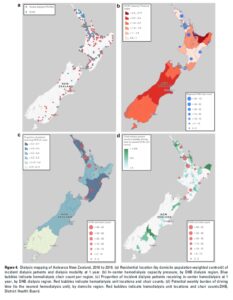1. Study Overview
The study “In-Center Hemodialysis and Patient Travel Time in Aotearoa New Zealand: A Nationwide Geospatial and Data Linkage Study” conducted in Aotearoa New Zealand is a nationwide geospatial and data linkage study. It aims to analyze the relationship between travel time and dialysis modality and propose improvements in kidney services[1].
The key objectives of this study are:
- Analyzing changes in hemodialysis patient travel time from 2006 to 2019
- Assessing the relationship between travel time and dialysis modality (in-center hemodialysis vs. home dialysis)
- Supporting kidney service planning using geospatial analysis
2. Research Methods
The study utilized the AcceSS and Equity in Treatment for Kidney Disease (ASSET) data platform to analyze data from 6,690 patients who initiated hemodialysis between 2006 and 2019 in New Zealand. The key research methods are as follows:
- Travel Time Calculation: Estimated driving time from the patient’s residence to the nearest hemodialysis center using Geographic Information System (GIS).
- Statistical Analysis: Used multivariate logistic regression analysis to assess the association between travel time and dialysis modality.
3. Key Findings
1) Travel Time Distribution
- The median driving time for all patients was 14 minutes (IQI: 8–31 minutes).
- Urban patients had an average travel time of 11 minutes (IQI: 8–18 minutes), whereas rural patients had a significantly longer travel time of 45 minutes (IQI: 28–62 minutes).
2) Relationship Between Travel Time and Dialysis Modality
- Patients who had to drive more than 30 minutes were 38% less likely to receive in-center hemodialysis.
- Capacity limitations of hemodialysis centers affected dialysis modality decisions.
3) Geospatial Analysis Results
- Significant disparities in hemodialysis services by region, with lower accessibility in rural areas.
- The distribution of dialysis centers greatly influences dialysis modality choices.

(a) Patient Residential Location and Dialysis Modality
- Red dots: Home dialysis (PD/HD)
- Blue dots: In-center hemodialysis (ICHD)
- Displays the dialysis modality choices of patients across New Zealand.
(b) ICHD Capacity Pressure Index
- Dark red areas: High capacity pressure regions (≥2.2)
- Lighter shades: Regions with relatively more availability
- Blue circles: Number of hemodialysis chairs per region
(c) Proportion of Patients Receiving In-Center Hemodialysis (ICHD) After One Year
- Darker shades: Regions with a high proportion of in-center hemodialysis patients
- Lighter shades: Regions with a higher proportion of home dialysis patients
- Red circles: Locations and chair counts of hemodialysis centers
(d) Weekly Travel Time Burden for Hemodialysis
- Dark green areas: Regions with shorter travel times
- Lighter green/white areas: Regions with longer travel times
4. Study Conclusions and Implications
The study emphasizes the need for innovative healthcare service improvements to reduce the travel burden for hemodialysis patients, including:
- Establishing small satellite hemodialysis centers
- Operating mobile hemodialysis units
- Expanding home dialysis support
- Considering travel burdens when planning medical services
- Addressing health disparities among vulnerable populations, such as Māori and Pacific Islander communities
This study presents a geospatial analysis-based healthcare optimization model applicable to other countries[1].
Hemodialysis Patient Travel Support in South Korea
South Korea is relatively well-equipped with hemodialysis centers, but some challenges remain.
1. Hemodialysis Accessibility in South Korea
✅ Distribution of Dialysis Centers:
- Dialysis centers are evenly distributed across the country.
- Most patients can access a dialysis center within 30 minutes.
- Major cities such as Seoul, Busan, and Daegu have numerous specialized dialysis clinics, and dialysis services are available in provincial areas.
✅ Health Insurance Support:
- National health insurance covers a significant portion of dialysis costs.
- Additional financial support is available for registered kidney disease patients.
✅ Differences in Dialysis Modality:
- South Korea has a high proportion of in-center hemodialysis patients.
- The adoption of home dialysis (including peritoneal dialysis) is relatively low, whereas New Zealand has a higher home dialysis rate.
2. Transportation Support for Dialysis Patients
✅ Disabled Transportation Services
- Patients registered with stage 2 or higher kidney disease can use disability taxi services and voucher taxis.
- However, high demand and limited supply make booking difficult.
- Nighttime (after 10 PM) and early morning dialysis patients (5–6 AM) face severe restrictions.
✅ Legal Issues with Hospital-Operated Transportation
- Hospitals operating transportation services for patients could be considered patient enticement, which is legally restricted.
- However, some hospitals unofficially provide transport services or collaborate with external organizations to support patient travel.
3. Areas for Improvement
🔴 Expansion of transportation support for nighttime and early morning dialysis patients 🔴 Addressing travel burdens for dialysis patients in remote and rural areas 🔴 Encouraging home dialysis adoption through policy initiatives 🔴 Considering the introduction of mobile dialysis services
4. International Case Studies and Policy Recommendations
✅ Delaware, USA: The Chronic Renal Disease Program (CRDP) provides free transportation services for dialysis patients. ✅ Australia: Mobile dialysis clinics operate in remote areas. ✅ United Kingdom: The NHS covers transportation costs for dialysis patients. ✅ New Zealand: Expanding home dialysis and mobile dialysis services.
➡ South Korea could benefit from international case studies to improve transportation policies and reduce the travel burden for dialysis patients.
References
- Birrell F, Marshall MR, Dunn A, Metcalfe S, Walker RC. In-Center Hemodialysis and Patient Travel Time in Aotearoa New Zealand: A Nationwide Geospatial and Data Linkage Study. Kidney Int Rep. 2025;10(6):921–934.
Is Pig’s Trotters (Jokbal) or Boiled Pork (Suyuk) a Better Choice for Diabetics?